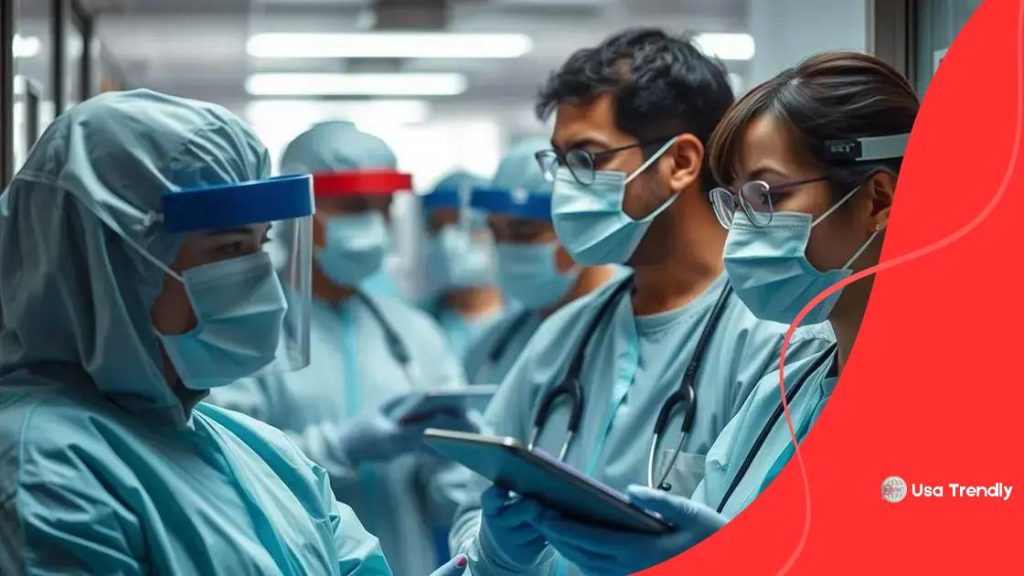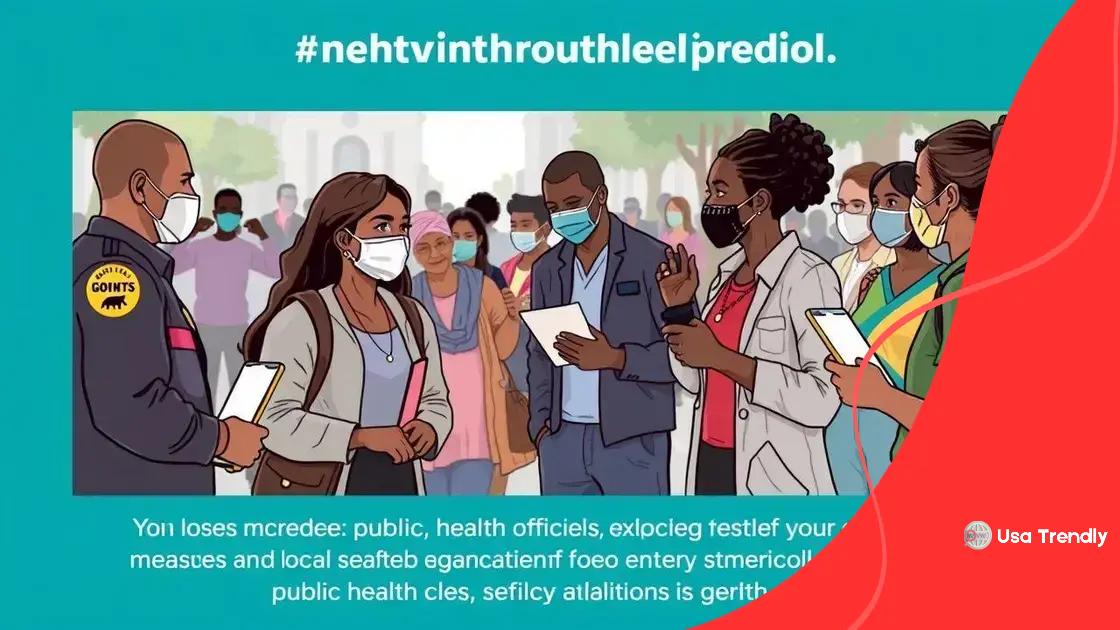Public health emergency responses activated: what you need to know

Public health emergency responses involve coordinated actions to protect communities, emphasizing flexibility, community engagement, efficient resource management, and the use of technology to address challenges effectively during crises.
Public health emergency responses activated are crucial in times of crisis. Have you ever wondered how these systems protect communities during outbreaks? In this article, we’ll explore key components and implications of these responses.
Understanding public health emergencies
Understanding public health emergencies is pivotal in safeguarding our communities. They occur when health threats are severe enough to affect public safety and well-being. These emergencies can arise from natural disasters, outbreaks of infectious diseases, or bioterrorism, necessitating a swift response from multiple agencies.
Key Characteristics of Public Health Emergencies
Every public health emergency shares certain characteristics that define its impact and response.
- Severity: The seriousness of the health threat influences the response level.
- Duration: Some emergencies are fleeting, while others may last weeks or months.
- Geographic spread: How widespread the health threat is can dictate resource allocation.
- Public perception: The way the public views the emergency can affect compliance with recommended health measures.
During a public health emergency, communication is key. Authorities need to keep the public informed about the situation, steps for protection, and available resources. Clear messaging can significantly reduce panic and misinformation.
The Role of Health Departments
Health departments play a central role in managing public health emergencies. They coordinate responses and ensure that the healthcare system is prepared for high demand. This includes stockpiling essential supplies, training healthcare personnel, and establishing rapid response teams.
In addition, collaboration is essential. Local, state, and federal agencies must work together to share information and resources. This unity enhances the effectiveness of the response and helps mitigate impacts on the community.
The experiences from past public health emergencies have led to improved strategies and planning. For instance, during the COVID-19 pandemic, innovative solutions were introduced, like telehealth services, enabling continued access to healthcare even during lockdowns. Lessons learned from these events help inform future preparedness efforts, ensuring that communities are better equipped.
How responses are activated
When a public health emergency occurs, quick action is essential. The activation of responses involves several critical steps designed to optimize resources and protect the community. Understanding this process can help individuals see how crucial it is to stay informed and prepared.
Identifying the Emergency
The first step to activating a response is identifying the emergency. This can involve monitoring disease outbreaks, environmental hazards, or any situation that may threaten health.
- Surveillance: Continuous monitoring helps detect issues early.
- Reports: Local health departments share information on emerging threats.
- Data analysis: Rapid assessment of the data aids decision-making.
Once an emergency is identified, public health officials engage their emergency response plans. These plans outline protocols for different scenarios, ensuring a coordinated effort.
Mobilizing Resources
The next phase is mobilizing resources. This involves coordination among local, state, and federal agencies. Each agency plays a unique role in the response effort.
- Funding: Financial resources may be allocated immediately to address the crisis.
- Supplies: Essential supplies such as vaccines, medications, and protective equipment are gathered.
- Personnel: Staff may be deployed from various health organizations to assist.
Communication is vital throughout this stage. Authorities must keep the public informed and address any concerns that arise. By sharing accurate information, they help guide the community in taking appropriate actions to stay safe.
In conclusion, understanding how responses are activated during a public health emergency can empower individuals and communities to be more proactive and better prepared. Awareness and preparation can make a significant difference when responding to health threats.
The role of community engagement

The role of community engagement is vital during public health emergencies. Engaging community members can enhance the effectiveness of responses and foster trust between public health authorities and residents. When people are involved, they feel more accountable and informed about the actions being taken.
Importance of Communication
Clear communication is a cornerstone of effective community engagement. Authorities need to share timely and accurate information with the public. This includes updates on health risks, safety measures, and available resources.
- Transparency: Keeping the community informed helps build trust.
- Feedback: Encouraging public feedback allows for better response planning.
- Accessibility: Making information available in multiple languages and formats ensures everyone can understand.
The gap between public health initiatives and community needs can often be bridged through engagement. Listening to community concerns and adjusting strategies accordingly shows that health officials value public input.
Building Partnerships
Community partnerships are essential in tackling public health crises. Collaboration with local organizations can maximize resources and outreach.
- Nonprofits: Partnering with local nonprofits can help distribute vital information and resources.
- Schools: Schools can be powerful allies in spreading awareness, particularly among families.
- Businesses: Local businesses can assist with resource distribution and promotion of safe practices.
Inviting community members to participate in planning and response efforts fosters ownership and responsibility. When people see their contributions making a difference, the overall effectiveness of public health responses increases.
Challenges in implementation
The challenges in implementation of public health emergency responses can significantly affect outcomes. Identifying these challenges is essential for improving readiness and effectiveness in future scenarios. Various factors complicate the activation and management of emergency plans.
Limited Resources
One major challenge is the limitation of available resources. During emergencies, demand for medical supplies and personnel often exceeds what is readily available.
- Funding gaps: Insufficient funding can hinder effective response efforts.
- Supply shortages: Critical supplies may be scarce during a crisis.
- Staffing issues: Many health workers may face burnout or be unavailable when needed most.
These limitations can lead to inefficiencies in response actions, making it harder to protect public health.
Communication Barriers
Effective communication plays a crucial role during emergencies. Barriers in communication can result in confusion and misinformation within the community.
- Language differences: Not all community members speak the same language.
- Information overload: Too much information can overwhelm the public.
- Misinformation: Rumors can spread quickly, creating panic.
Addressing these barriers is crucial for ensuring that communities receive accurate information and guidance during emergencies.
Furthermore, fostering collaboration among local agencies can be challenging. Different organizations may have varying priorities or protocols, which complicates unified action. Building a strong foundation for cooperation before emergencies arise can aid in smoother teamwork during a crisis.
Future considerations for public health policies
Future considerations for public health policies are essential to enhance preparedness for emergencies. As the world changes, these policies must adapt to new challenges and opportunities. Addressing evolving health concerns keeps communities safe and resilient.
Emphasizing Flexibility
One significant aspect is the need for flexibility in public health policies. Policies that can quickly adapt to changing circumstances are more effective during crises. This includes having guidelines that can be adjusted based on local conditions and emerging data.
- Real-time data: Utilizing up-to-date health information helps refine responses.
- Adaptive measures: Policies should allow for adjustments as situations develop.
- Feedback loops: Incorporating community feedback can enhance policy effectiveness.
Flexibility ensures that the health system can respond better to unpredictable events, making it a vital consideration for future planning.
Strengthening Community Involvement
Engaging the community in public health decision-making processes is another critical consideration. Residents need a voice in shaping the policies that affect their health directly. Active participation leads to higher compliance and trust in public health measures.
- Public forums: Hosting discussions allows residents to express their concerns and ideas.
- Collaborative initiatives: Partnerships with local organizations can drive health initiatives.
- Education programs: Empowering communities through education fosters informed participation.
Encouraging this involvement can result in policies that reflect the needs of the community more accurately.
Lastly, investing in technological advancements will play a key role in future public health policies. Innovative technologies can enhance data collection, streamline communication, and improve overall response strategies. Incorporating digital tools not only modernizes public health efforts but also prepares for challenges ahead.
FAQ – Frequently Asked Questions about Public Health Emergency Responses
What is a public health emergency?
A public health emergency is a significant threat to health that requires immediate action, often due to outbreaks, disasters, or bioterrorism.
How can community engagement improve health responses?
Community engagement builds trust and ensures that responses address the specific needs and concerns of the population.
What challenges do public health officials face during emergencies?
Challenges include limited resources, communication barriers, and the need for flexibility in policies to adapt to rapidly changing situations.
Why is technology important in public health policy?
Technology enhances data collection, improves communication, and facilitates efficient resource management during public health emergencies.
SEE MORE CONTENT